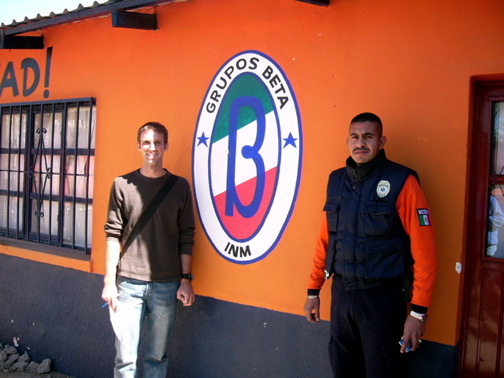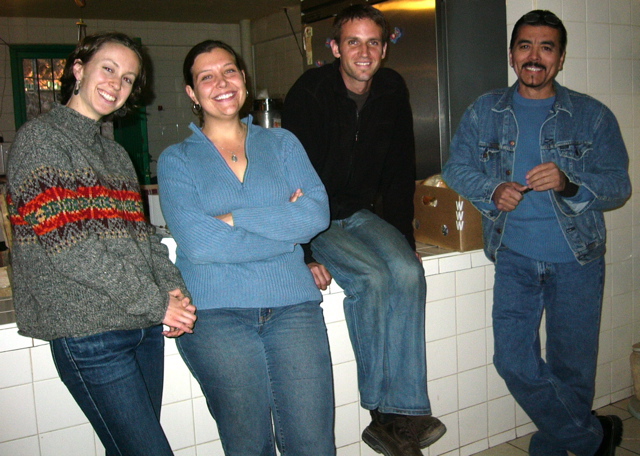|
|
||||
|
BorderLinks: A Trip to Nogales, Mexico On Feb. 23, 2006 our class took a day-long field trip to Nogales, Mexico to take a first hand look at the effects of globalization on this Arizona-Mexico border town. Our trip initially began in Tucson, Arizona where we met with Border Links, an Arizona based organization that focuses on educating people on the existing relationship between the U.S. and Mexico and what effects this relationship has on both countries. In order to achieve this, Border Links guides people, and students such as us, through specific cites and visitations that best exemplify both the harsh conditions that currently exist in Nogales and some of the measures being taken to help the ever-growing population cope.
Our trip in Nogales, Mexico began with a visit to the organization Grupo Beta. Funded and supported by the Mexican government, Grupo Beta was designed to help aid and educate Mexican and Central American immigrants that have either been returned to Mexico by U.S. authorities, or are potentially going to make an attempt to immigrate to the U.S. Grupo Beta specifically provides the education that many of these people need in order to ensure their safety and, to a certain extent, their protection across the border. During our visit at Grupo Beta, one of the experiences that had the biggest emotional impact on me was a conversation our group had with a family of recently returned immigrants. During the course of this conversation we learned some of the harsh conditions this family had to face on their journey across the border as well as some of the difficulties they were having adjusting to their current situation. After hearing of their struggles and difficulties, one couldn’t help but wonder what would compel someone to just up and leave their home in order to risk their lives to go north. In order to better understand such a decision it is important to examine Mexico’s current economic situation. As described in Steve Suppan’s article “NAFTA’s Impact on Mexican Agriculture and Rural Life,” Mexico’s economic situation has been steadily declining since the devaluation of the Mexican peso in 1994. As a result of the peso’s loss in value there arose increases in interest rates on loans, reductions in productions of basic grains and foods, and the increase in overall poverty throughout the country. In what was touted as an effort to aid Mexico and benefit the U.S. the Clinton administration presented and approved the North American Trade Agreement (NAFTA). NAFTA provided open trade agreements that were meant to benefit business owners and entrepreneurs on both sides of the border. Ultimately, it did little to improve Mexico’s economic situation and only help shift poverty to the north. With the steady decline in market value for Mexican grown grains as a result of U.S. imports, Mexican farmers were often forced from their land and to the cities in order to find work. It is this type of migration that had lead to the massive increase in population along the U.S.-Mexican border where U.S. owned assembly factories promise employment opportunities and an escape from the rural poverty migrants are leaving behind. This illusion is quickly diminished and replaced by the reality that actually awaits recent migrants to the border. High living costs and low wages in maquiladoras often force migrants to even more extreme poverty along the border where many of them set up make shift homes that lack running water, electricity, and sanitation. It is these conditions that often leave many migrants with little hope and a desire to take their chance immigrating to the U.S. even if it means doing so illegally. Furthermore, with the massive amounts of repatrionized people being returned to Mexico everyday, it is important to see why organizations such as Grupo Beta have become necessary, if not vital, for immigrants. Another part of our trip that I found to have a strong impact on me was a meeting that occurred prior to entering Mexico; it was our meeting with the representative from No More Deaths. Though I’d already been pretty well versed on what it was that No More Deaths was about it wasn’t until hearing firsthand what the situation is like in the Arizona desert for immigrants entering the U.S. from Mexico that I truly began to understand the necessity for such an organization. After reading Tim Stellar and Igncio Ibarra’s article “Searing heat, soaring toll: Increasingly crossers aren’t likely to survive,” I began to understand some of the conditions that have contributed to the increasing number of deaths on the U.S.-Mexico border. The recent militarization of former popular entry ports to the U.S. along the Arizona border have lead immigrants to attempt their journey through the dangerous, and often deadly, Arizona desert. It is along this journey that many immigrants ultimately succumb to heat, dehydration, or exhaustion. It is from this crisis that organizations such as No More Deaths have emerged in order to provide medical aid, food, and water to immigrants making their journey through the Arizona desert. Consisting largely of volunteers and humanitarians, No More Deaths sets up camps known as “Arks of the Covenant” throughout the Arizona desert. Most recently, No More Deaths has, much like many humanitarian groups before them, come under fire for their tactics after two members were arrested for their role in aiding ailing immigrants. Ultimately, I found our trip to Tucson and Nogales to be both educational and moving. It was in being there first hand and truly analyzing the situation from all perspectives that I truly came to understand some of the difficulties immigrants are facing in my own “back yard.” I recommend this trip for any individual who is interested in gaining a better understanding on the effects that globalization, development, and im/migration can have on the communities and the individuals that live within those communities. Click Here to visit the BorderLinks Website
A big "Thank You" to our BorderLinks guides! (Above) |
|||
|
||||


